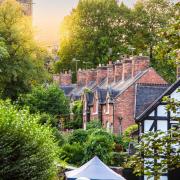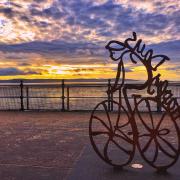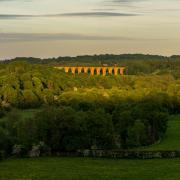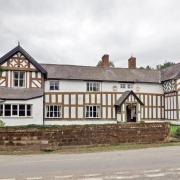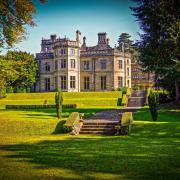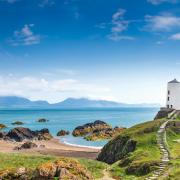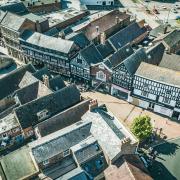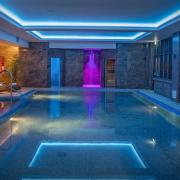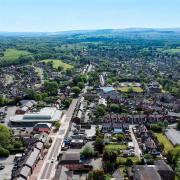At first glance, Tarporley could be one of many quintessentially rural English villages or small towns. But delve a little deeper and you’ll find a range of shops that’s hard to match.
It’s the nature of these businesses that make Tarporley so special, the High Street and Park Road, are home to unique, independently owned stores.
Traders say this independent spirit is vital to Tarporley's success.
'Tarporley is a busy village with many owner-run shops. There’s a vibrancy and so much choice,' says Mary Brogelli, of Baile Home. 'It’s a great place to do business. There’s a spirit of co-operation, with everyone working well together, and we’re supported by a loyal customer base.'

This positive spirit was in evidence when I visited the Rascal and Radical bar on a weekday morning. The High Street venue was packed with small-business owners and entrepreneurs, attending a networking event organised by marketing agency owner Alex Morrisroe.
Jan Cameron, chair of the Tarporley Business Club, told me: 'We have a special energy here because local businesses love to get together and support each other.'
Estate agent Oliver Ball, another attendee at the Grub and Grow networking event, described Tarporley is a sought-after area in which to live, with a buoyant housing market.
'There are several different reasons why Tarporley is attractive to home buyers,' added Oliver, of Lawrenson Ball. 'It has a vibrant centre, excellent quality schools, there’s a great number of high-quality homes, and we’re seeing a trend, particularly post-Covid, of people moving out of cities and into rural towns and villages.'

The diverse High Street makes Tarporley an unexpected destination for discerning shoppers from Cheshire and North Wales.
It’s renowned as a must-visit place for high-end fashion buyers and is home to several interior design specialists.
Popular independent shops include women's designer fashion boutique Si Belle; Follies of Tarporley, a lady’s outfitters with a wide choice of designer wear; Hoity Toity Shoes; Ginger and Pickles Bakehouse; the Little Potting Shed and florist Bramble and Blooms.

Baile recently moved from the High Street to Park Road in search of a larger more suitable space. Mary Brogelli describes her stock as everything handmade or rugged, from small furnishings to Donegal sweaters – a reflection of the owner’s Irish roots.
'There are lots of shops I would recommend and many are family-owned. Our neighbour, Follies, was set up by the mother of the current owner.'
Zara Rafferty, of Zara Elizabeth Interiors, said: 'Tarporley is a beautiful part of Cheshire and the High Street has an excellent community of shops, bars, and places to eat. I founded the business in 2016 and have created a wonderful portfolio of clients. I have completed many prestigious properties across Cheshire and beyond, working with suppliers from fabrics to furniture, and the best architects, lighting designers, curtain makers and carpenters, and they are all based in Cheshire.'
Tarporley also ticks the boxes for visitors looking for places to eat and drink. Coffee shops and tea rooms include Latte Da, on the High Street, which is popular for morning coffee or afternoon tea and has an attractive outdoor seating area. Nearby you will find Fuel, part of the Instinct fitness and wellbeing suite, with a coffee shop that also specialises in health food and drink.
The delightful Lockgate Coffee House, on the outskirts of town, is popular with walkers and cyclists, and as a dog-friendly venue, even offering a canine menu.
There’s an excellent choice of restaurants and bars serving Tarporley. The Swan, at the heart of the High Street, describes itself as a classic British inn. Owned and run by local company, Bear Inns, it has been welcoming visitors for more than 400 years.

It serves as a focal point for many Tarporley events, including a comedy club. Woody Barlow, founder and director of Bear Inns, says: 'The Swan has four centuries of history and is at the very heart of the community, open all day, every day. It’s a place where visitors can enjoy a warming cappuccino, breakfast, lunch, or dinner from a great selection of locally sourced produce.'
Nearby, you’ll find the Little Tap, renowned for its inventive small plates menu, craft beer and spirits. The Coast restaurant and bar has an Italian-influenced menu, while the Foresters Arms is a more traditional pub, with a restaurant and accommodation.
The Rascal and Radical is a recent addition to the High Street. Historically the building was Tarporley’s old fire station, and most recently a chocolate shop. It was bought by the Cheshire Pub Company. and has benefitted from an extensive refit.
Owner Simon Kalton says: 'We had been looking for a location in Tarporley for some time because it is a place with an active village centre and friendly shops.
'The company has spent around half a million pounds on the kitchen, bar and fittings, and it’s going well, with excellent support from visitors from Tarporley and further afield.'

The parish church, St Helen’s, is located centrally on the High Street and parts of the building date back to the 15th century.
Tarporley is also a popular destination for golfers – the Portal Golf and Spa Resort has a four-star hotel, three golf courses – including one of championship standard course offering a good challenge to even the best players – and spa and swimming facilities in which to ease the aches and pains following a day on the fairways or walking in the Cheshire countryside.

What to see
Tarporley is located less than 11 miles away from the walled city of Chester, with its extensive shopping, history and tourism offer. But the village has its own visitor attraction – Beeston Castle – within its boundaries.
Sitting atop a rocky crag high above the Cheshire Plain, Beeston is one of the most dramatically sited medieval castles in England. On a clear day, you can see all the way from the Pennines to the Welsh mountains.
The grounds of Beeston Castle feature a replica Bronze Age roundhouse and a 40-acre woodland park.
From the top of the castle walls, visitors can peer down into the castle well, said to be the hiding place of Richard II's lost treasure.
Beeston Castle was built by the Sixth Earl of Chester in the 1220s and incorporates the banks and ditches of an iron hill fort. Henry the Third seized the castle in 1237 and it remained in royal ownership until the 16th century.
During the English Civil War, Beeston was seized by Cromwell’s forces and partially demolished in 1646.
Peckforton Castle is just a short distance away, but is very different from its neighbour, both in its history, and modern use, as it now houses a luxury hotel.
The castle was built between 1840 and 1851, in a medieval style, as a home for the Tollemache family. The modern-day hotel has 48 individually designed guest rooms and the venue has also proved popular as a film and TV location.
The Ice Cream Farm in nearby Tattenhall is a popular family visitor attraction, while Bunbury Mill is home to a working 100-year-old water-powered mill and has a visitor centre and tea room.

Two castles on one walk
A circular trail, exploring the Beeston and Peckforton Hills, affording spectacular views of Beeston and Peckforton castles, is popular with walkers.
It’s a relatively short circuit, at less than four miles and is graded as an easy to mid-difficulty walk, but it can become very muddy during prolonged wet weather.
Starting from Beeston Castle car park (pay and display), opposite Beeston Castle gateway, Chapel Lane, Beeston, walk left along the road for just a few yards then bear right along a fenced footpath beside the entrance to the Sandstone Café.
The easy-to-follow path goes down to a lane opposite a house called Tabernacle Cottage. Turn left up the lane and then, a few yards later, right up steps and onto the Sandstone Trail, crossing a field. Here you’ll gain a view of Peckforton Castle, poking through woodland.
Proceed down some steps, over a footbridge and on to a junction of paths. Walk straight on, following the Sandstone Trail along a right-hand field edge. Go through a kissing gate and across the next field to the next kissing gate, and on to Horsley Lane. A right turn takes you to Ivy Cottage, at which point you should go left through a metal gate following the Sandstone Trail into the Peckforton Estate.
You will reach a way marker indicating that the sandstone trail turns left but go straight on and walk downhill to a metal gate where you’ll join Pennsylvania Lane. From here, walk towards the Pheasant Inn.
Follow the lane to a T-junction, bear left uphill, then go left again into Rock Lane. When the road forks, Rock Lane goes to the left, but you need to stay right as the road becomes Hill Lane. You will pass a way marker for the Sandstone Trail but keep going straight ahead, and through a gate where the lane turns into a wide unmade track through a lightly wooded area.
Once you reach a large stone arch, the lane becomes asphalted. Continue until you reach the gatehouse for Peckforton Castle and Peckforton Road.
Walk on to a private lane on the Peckforton estate and look for the gate on the right signposted for Beeston Castle.




